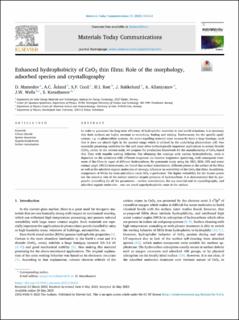| dc.contributor.author | Mamedov, Damir | |
| dc.contributor.author | Åsland, Anna Cecilie | |
| dc.contributor.author | Cooil, Simon Phillip | |
| dc.contributor.author | Røst, Håkon | |
| dc.contributor.author | Bakkelund, Johannes | |
| dc.contributor.author | Allaniyazov, Atabek | |
| dc.contributor.author | Wells, Justin William | |
| dc.contributor.author | Karazhanov, Smagul | |
| dc.date.accessioned | 2023-08-14T10:52:56Z | |
| dc.date.available | 2023-08-14T10:52:56Z | |
| dc.date.created | 2023-06-02T18:17:27Z | |
| dc.date.issued | 2023 | |
| dc.identifier.citation | Materials Today Communications. 2023, 35 . | en_US |
| dc.identifier.issn | 2352-4928 | |
| dc.identifier.uri | https://hdl.handle.net/11250/3083783 | |
| dc.description.abstract | In order to guarantee the long-term efficiency of hydrophobic materials in real-world situations, it is necessary that their surfaces are highly resistant to scratching, fouling and misting. Furthermore, for the specific applications, e.g. in photovoltaic systems, the water-repelling material must necessarily have a large bandage, such that it does not absorb light in the spectral range which is utilized by the underlying photovoltaic cell. One especially promising candidate for this and many other technologically important applications is cerium dioxide (CeO2, ceria). In the current study, we propose the production framework for the manufacturing of CeO2-based thin films with tunable wetting behavior. For obtaining the coatings with various hydrophobicity, ceria is deposited on the substrates with different roughness via reactive magnetron sputtering, with consequent treatment of the films in vapor of different hydrocarbons. By systematic study using the XRD, SEM, XPS and water contact angle (WCA) instruments, we found that surface texturization, different plains at the surface of the films as well as the adsorbed organic molecules all strongly influence on wettability of the CeO2 thin films. In addition, comparison of WCAs for ceria and silicon oxide SiOx is performed. The higher wettability for the former points out the essential role of the surface material despite presence of hydrocarbons. It is demonstrated that by purposeful controlling for all the parameters – surface texturization, the top material and its crystallography, and adsorbed organic molecules – one can reach superhydrophobic state of the surface. | en_US |
| dc.language.iso | eng | en_US |
| dc.publisher | Elsevier | en_US |
| dc.rights | Navngivelse 4.0 Internasjonal | * |
| dc.rights.uri | http://creativecommons.org/licenses/by/4.0/deed.no | * |
| dc.title | Enhanced hydrophobicity of CeO2 thin films: Role of the morphology, adsorbed species and crystallography | en_US |
| dc.title.alternative | Enhanced hydrophobicity of CeO2 thin films: Role of the morphology, adsorbed species and crystallography | en_US |
| dc.type | Peer reviewed | en_US |
| dc.type | Journal article | en_US |
| dc.description.version | publishedVersion | en_US |
| dc.source.pagenumber | 8 | en_US |
| dc.source.volume | 35 | en_US |
| dc.source.journal | Materials Today Communications | en_US |
| dc.identifier.doi | 10.1016/j.mtcomm.2023.106323 | |
| dc.identifier.cristin | 2151426 | |
| dc.relation.project | Norges forskningsråd: 309827 | en_US |
| dc.relation.project | Norges forskningsråd: 262633 | en_US |
| cristin.ispublished | true | |
| cristin.fulltext | original | |
| cristin.qualitycode | 1 | |

